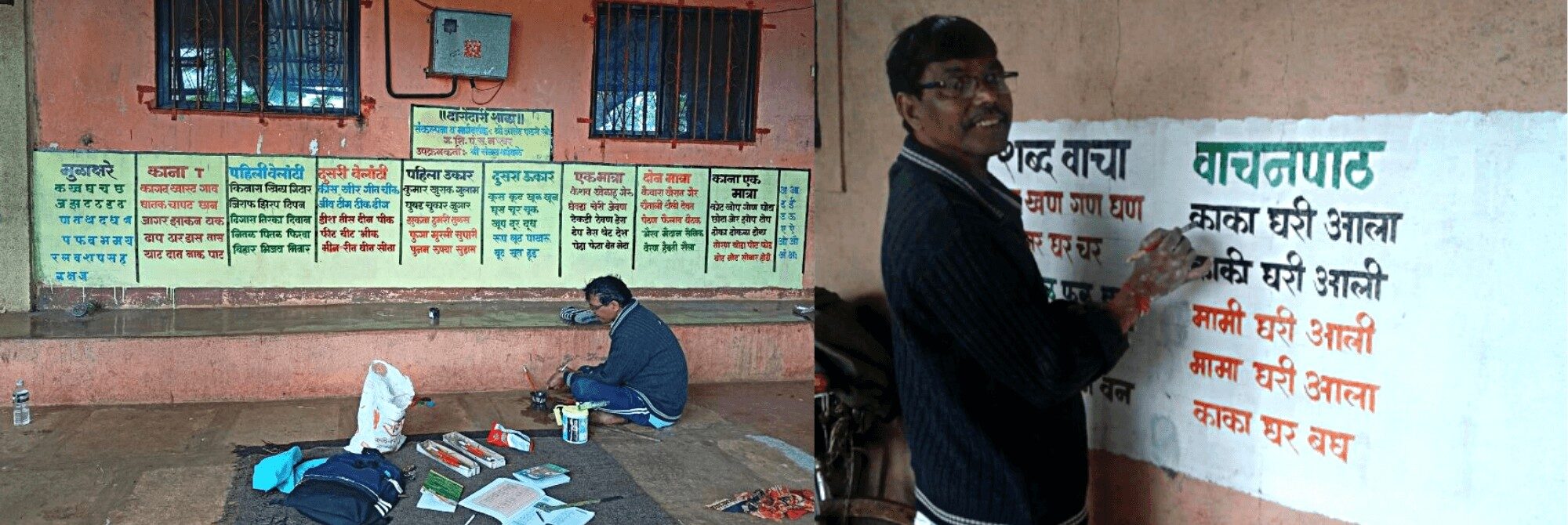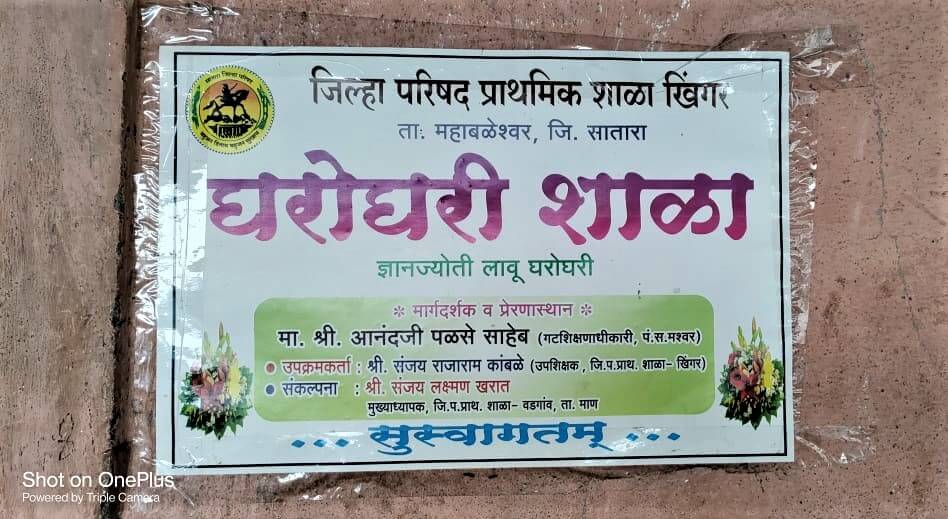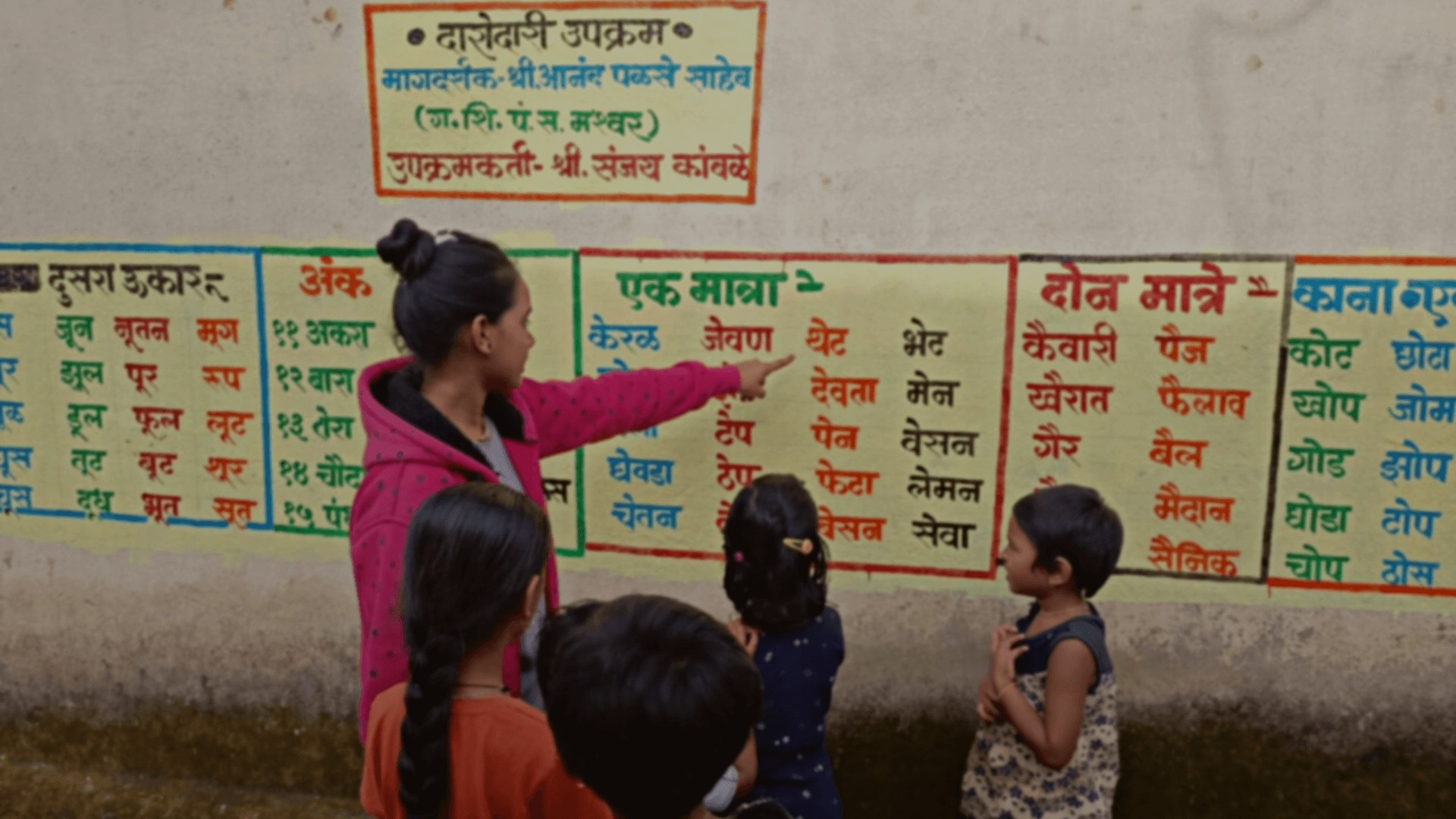“My son started reading small words only because of these [alphabets and numbers] paintings on the wall—he learned them unconsciously as a part of the play [during the pandemic],” says the parent of a 6 year old in Maharashtra’s Mahabaleshwar block, around 120 kilometres from Pune. While numerous research studies suggest that education at every level has been impacted due to the COVID-19 pandemic, elementary education in particular has been the worst hit. The Zilla Parishad school in Mahabaleshwar block’s Khingar village decided to address the pandemic-induced gaps by providing elementary education and bolstering parent engagement.

When one enters Khingar, a village of more than 250 families, it is hard to not notice the beautifully painted walls—paintings of alphabets, numbers, short phrases, and words in Marathi and English. Inside the homes of elementary students, at least one of the walls has papers with alphabets and numbers stuck to the walls. Since we were visiting the Zilla Parishad schools in the block, to learn and document the impact of parent-school engagement on students’ learning outcomes post the pandemic forced school closures, we were curious to know more.
On inquiring about the wall paintings, the teachers shared that they were painted by Sanjay Kamble, a primary school teacher at Khingar. In July 2021, as a part of a local initiative to boost the engagement of parents in their child’s education, Sanjay started painting the walls. Ever since, Sanjay’s initiative is one that has proved to be a valuable learning for promoting education in Mahabaleshwar block.

Bringing Education Closer to Home
The wall paintings in Khingar are a result of a meeting with Zilla Parishad teachers that was requested by Anand Palse, Block Education Officer (BEO), back in April 2021. In the backdrop of the series of COVID-19 lockdowns, Palse highlighted the issue of school closures and educational setbacks. He asked the teachers in his block to come up with innovative and creative ideas to encourage children to continue their education journey by reading and writing even in scenarios when schools were closed. Sanjay Kamble, who was part of this meeting with the BEO, was motivated and determined to devise an initiative for the children in his village. This is when the idea to paint on the walls occurred to him.
What encouraged us [the teachers] is that we were given the freedom and authority to decide and devise creative methods at the local level. I started exploring on YouTube when an idea clicked! So what if the students cannot go to school? Could I take the school to the students’ homes?
—Sanjay Kamble
Sanjay purchased the required material for painting—paints, brushes, glue, and more— with which he began painting and sticking posters on some of the community walls such as fences of houses, side walls of houses, walls of the government offices and inside homes of elementary graders. Additionally, the parents and family members were requested to read out to their children at least once a day. At the community level, he urged the older students to read out the paintings on the walls to the children while they gathered to play on the ground. For a long time now, Sanjay has been active in successfully implementing education policies at the community level and has received several accolades for his participation.

When the local gram panchayat came to know about Sanjay’s wall painting initiative, they extended financial support to purchase the painting material. Overtime, the community and parents have also been supportive; none of them have objected to the paintings or sticking of posters on their walls. When the BEO learned of this initiative, he awarded Sanjay for this idea and named it ‘Gharoghari Shala Yojana’ [in Marathi, ‘Door to Door School’]. On receiving support from the administration, Sanjay went on to paint several other walls in Khingar.
I discussed the idea with the parents of an elementary grader—let’s paste the letters and numbers in Marathi and English on one of the walls of a house so that someone in the family could read it to the child whenever time permits. This one family allowed me to paint, but others showed resistance. That is when I received the support of the Gram Panchayat Secretary, who walked with me to the homes to talk to the parents about how helpful this idea could be for the children. Once the parents were convinced, I went a step ahead with the plan to paint and stick posters on the walls. I first painted the walls of the homes of elementary graders and then proceeded to paint outside government offices, side walls, fences, etc. I received good support from the parents and the local body leaders.
—Sanjay Kamble

Parent Engagement Makes a Difference
Due to the pandemic, prolonged school closures have created a new need—educating students in their homes. As schools begin to work around this new need and devise strategies, parent-engagement will need to be a priority. A recent report published by the Brooking Institution, highlighting two major strategies to improve learning outcomes—through improving and transforming the system.
Within these two strategies, the report defines the four goals of parent-engagement. Firstly, to improve the attendance and completion of students. Secondly, improving the learning and development of students. Thirdly, redefining the purpose of school for students. Finally, redefine the purpose of school for society. Apart from the need to transform service delivery to achieve desired outcomes, the benefits of parent-engagement include, better academic performance, improved test scores, better time management, and more.

In the case of the Gharoghari Shala Yojana, the program enables parents to become active participants in their child’s education. This gives parents a sense of satisfaction and motivation to support the education system as active collaborators for student learning. As seen in the strategy map, the Gharoghari Shala Yojana has been helpful in actively engaging parents according to the family role, place, and lever to achieve the four goals at varying levels. The administration views family-engagement as an important strategy in supporting the holistic development of both teachers and students to achieve higher learning outcomes for students. “The main benefit of parent-engagement is that the child is on a continuous watch, be it at school or home. This helps in the perfect grooming of the child,” says Anand Palse, the BEO.
Collaborating for Success: Engaging Parents and the Community
Mahabaleshwar is a hill station known for its strawberries, which hold a geographical identification (GI) status. During the visit, it was found that most parents are engaged in strawberry cultivation or its marketing due to which they are unable to pay attention to the education needs of their children. The parents, however, see Gharoghari Shala Yojana as a reliable option to ensure their children continue education at home too. “Children can read out the walls while the parents do other activities at home such as cooking, cleaning, etc. More importantly, children started reading words and numbers even before the schools reopened,” says a mother.

Given the increasing demand for parent-engagement in the school education system, the role played by Leadership for Equity (LFE), a systems change and advisory organisation, by collaborating with the administration is vital. By extending support to the administration for accelerating parent-engagement in the Mahabaleshwar block, a program named “Maze Ghar Maze Shala” (My home my school) has been designed along with the BEO. The goals of the program are aligned with the NIPUN Bharat Abhiyan guidelines to improve parent involvement and engagement. The idea is to create and share small weekly activities with parents of grades 1 to 7. The created activities are coupled with the local culture and lifestyle of parents to enable a conducive learning environment at home. The activities include posters indicating engagement strategies that are released on WhatsApp groups, and the content of the posters is evaluated by both the BEO and LFE team members. A positive response from the parents and community members to the engagement strategies has motivated both the teachers and administration about the Program.
Our initiatives at the community level could only be successful with the active participation of family members in their child’s education. The parents are completing the posters shared on the groups.
—Anand Palse, BEO

Understanding the importance of parent-engagement in public education to improve and transform the system is the need of the hour. Research suggests that the active role of parents in their child’s education acts as an enabling factor to improve student learning outcomes. Here strategies like the ‘Gharoghari shala yojana’ or the ‘Maze Ghar Maze Shala’ program can act as a breakthrough in the regions where the community is majorly dependent on the public education system and parents cannot invest the required time and resources in educating their children. There is a great need to scale up the concept at larger levels, where it would include all the steps like spreading awareness, developing strategies, and implementing those among communities.
Featured image is of a youth in Khingar village reading out words to young girls; image courtesy: Leadership for Equity







दिव्यत्वाची प्रचिती तेथे कर माझे जुळती माझे प्रेरणास्थान महाबळेश्वर तालुक्याचे आदरणीय गटशिक्षणाधिकारी श्री आनंदजी पळसे साहेब यांच्या मार्गदर्शनाखाली व संकल्पनेतून covid-19 च्या काळामध्ये दारोदारी शाळा हा उपक्रम खिंगर गावांमध्ये राबवण्यात आला. हा उपक्रम राबवण्याची खरी प्रेरणा मला साहेबांच्या मुळे मिळाली मी त्यांचे शतशः आभार व धन्यवाद मानतो या उपक्रमासाठी सहकार्य करणाऱ्या खिगर गावांमधील असणाऱ्या माता व ग्रामपंचायत यांचे देखील मी आभार मानतो तसेच या उपक्रमाची दखल सोमनाआचार्य मॅडम यांनी घेतली याबद्दल देखील त्यांचे मी आभार मानतो
दिव्यत्वाची प्रचिती तेथे कर माझे जुळती माझे प्रेरणास्थान महाबळेश्वर तालुक्याचेआदरणीय गटशिक्षणाधिकारी श्री आनंदजी पळसे साहेब यांच्या मार्गदर्शनाखाली व संकल्पनेतून दारोदारी शाळा हा उपक्रम covid-19 च्या काळामध्ये राबवण्यात आला हा उपक्रम राबवताना खरी प्रेरणा मला साहेबांच्या मुळे मिळाली. मी त्यांचे शतश,: धन्यवाद व आभार मानतो तसेच या उपक्रमाची दखल सुमना आचार्य मॅडम यांनी घेतली यांचे देखील मनापासून मी खूप खूप आभार मानतो
Very very nice. Mr. Kamble Sir is very active teacher. Salute to their excellent work, And our respected inspire Block Education Officer Mr. Palase Saheb.
Its really great work really great .salute to them
your article is very simple and atreative and thinkable for a villagers must think about this.
your post is very nice related to village education we have required like this post to incourage the village people